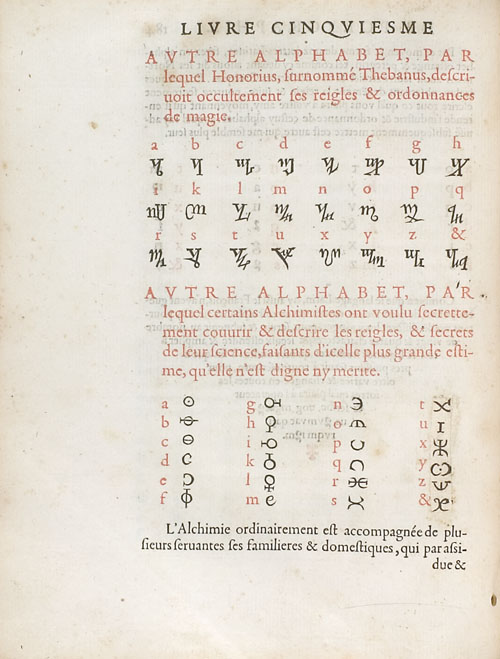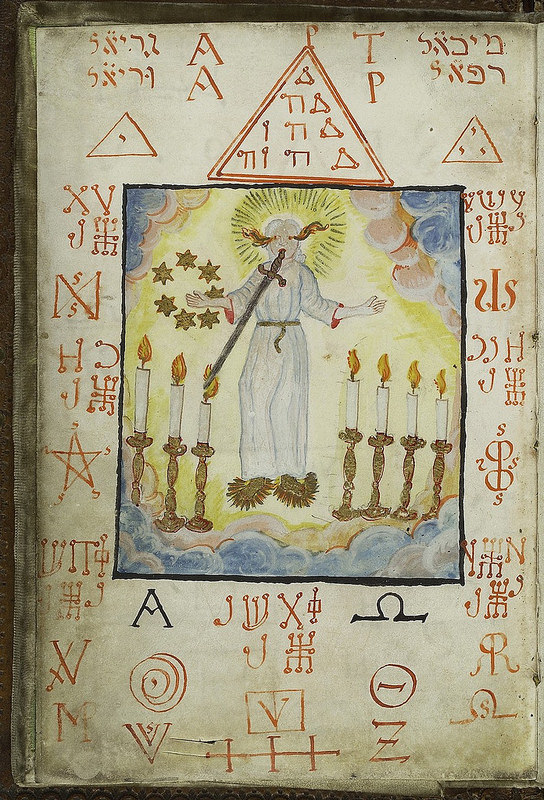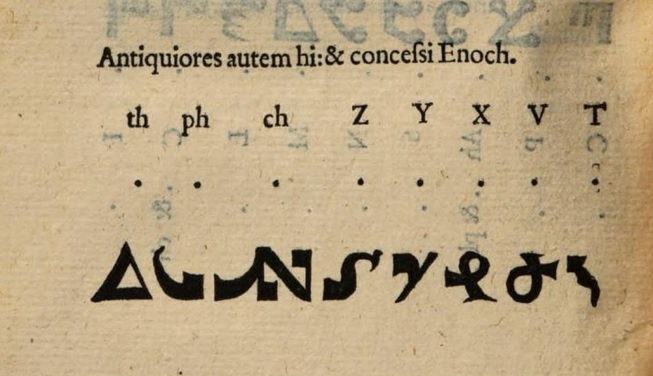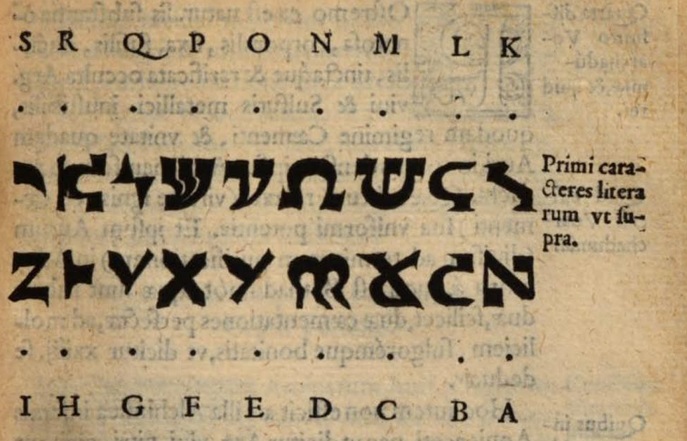
Karswell had borne ill-will to my brother… and now his book seemed to me to be a very sinister performance indeed. One chapter in particular struck me, in which he spoke of “casting the Runes” on people, either for the purpose of gaining their affection or of getting them out of the way — perhaps more especially the latter: he spoke of all this in a way that really seemed to me to imply actual knowledge.
M. R. James – ‘Casting the Runes’
Writing has always had an association with magic. As I mentioned in a previous post, it’s easy to see how in a world of limited literacy, people might attribute supernatural qualities to these strange signs that allow initiates to recall the lore of times past or speak things they had never personally been told. It’s likely that abecedaries sometimes had magical significance in the ancient world, and we have examples of magical spells written down as early as Bronze Age Mesopotamia.
People have also often looked back to the writing systems of earlier periods, believing them to have special powers and connections to the lost secrets of elder times. As the title of this article suggests, Germanic runes have been one of the more popular examples, having enjoyed a particular resurgence in the 18th to early 20th centuries and being especially associated with divination. They’re not the only one, though. Unsurprisingly, given the particular affinity many modern would-be mages feel for Celtic traditions, the Ogham script of early mediaeval Ireland has also been widely embraced, as have Mesopotamian cuneiform and, of course, Hebrew. The use and reception of these ancient systems in modern magical beliefs could easily fill a lengthy blog post, if not an entire book, but it’s not what I’m going to focus on today. Instead I want to look in particular at those writing systems created specifically for magical purposes.
There are a great many of these, and, as we’ll see, they really come to prominence during the Renaissance, when magic and alchemy were just beginning to distinguish themselves as separate disciplines from science. Although there had been magical and esoteric traditions stretching right back into antiquity (I’ve talked about them before in a previous post), the Renaissance and early Enlightenment was when they began to crystallise into their modern forms. These invented writing systems were part of that.
The motives behind their creation varied of course: partly the goal was secrecy, ensuring one’s arcane knowledge was only accessible to fellow initiates; in other cases, the writing itself was thought to have magical qualities. As we look through just a few important examples, we’ll start to see some of the common themes and how they relate to wider cultural and scholarly concerns of their time.
The Theban Alphabet
Let’s start with the ‘Theban Alphabet’. It was so called because it was attributed to a possibly-mythical mediaeval sorcerer known as Honorius of Thebes, but in reality its first appearance is in the work of Johannes Trithemius, a Benedictine abbot, scholar and occultist who lived in the early 16th century.

As you can see from the sign repertoire, the Theban Alphabet omits the letters J, V and W – namely, those letters that didn’t exist in classical Latin. This makes it effectively a substitution cipher for Latin, as befitted that language’s role as the near-universal language of scholarship and ancient knowledge at the time. Like most of the writing systems we’ll look at, it’s never entirely fallen out of use and continues to be employed within some latter-day magical and neo-pagan traditions.
Transitus Fluvii

Soon after Trithemius published the Theban Alphabet, a German mercenary, scholar, and occultist (a combination somewhat less common in modern academia, as far as I know) named Heinrich Cornelius Agrippa published three volumes on occult philosophy. The third volume includes a collection of magical writing systems, including the Theban Alphabet but also several others. Probably the best-known of these is the script known as ‘Transitus Fluvii’ – Latin for ‘The Crossing of the River’. Like many Renaissance magical writing systems, it’s derived from Hebrew, reflecting the popular idea that Hebrew was the original (or at least oldest surviving) human language, and the one God used to communicate with Adam and Moses. As such, many believed it had special powers and was the one best used for communicating with holy or unholy beings. Transitus Fluvii has had an interesting afterlife. In the eighteenth century it was used for the notorious black magic grimoire Clavis Inferni (‘The Key to Hell’), which supposedly came from a German school that taught the dark arts.


Agrippa’s occult works have also had a long association with horror fiction. They’re mentioned in Mary Shelley’s Frankenstein as among the early inspirations for her eponymous doctor and, more recently, Transitus Fluvii appeared in the film The Blair Witch Project. At least, so I understand; I can’t offer first-hand testimony of that because I’m a bit of a wuss when it comes to horror movies and haven’t seen it.
Agrippa also published two other magical alphabets which hadn’t been seen before: the Celestial Alphabet and Malachim. Like Transitus Fluvii, these also derive from Hebrew. Like Trithemius before him, Agrippa didn’t claim to have invented or discovered these scripts himself, but painted them as having a long and ancient tradition. In this case, they were supposedly passed down by Jewish Kabbalists and mystics. This may well be true, but it’s at least as likely that Agrippa simply made them up.


Enochian

 Slightly later in the 16th century, we encounter the famous Dr John Dee, one of history’s more colourful characters. He served at the court of Elizabeth I as a scientist, astronomer, and probably a spy (who seems to have signed his letters ‘OO7’), but he was also up to his eyeballs in the occult. He was particularly interested in contacting angels through a process known as scrying – staring into a mirror, crystal ball or other polished surface. Many of Dee’s magical paraphernalia and journals are now held by the British Museum and British Library, including his obsidian Aztec ‘scrying glass’. If you got a chance to visit the British Library’s excellent Gothic exhibition a few years ago, you may well have seen them.
Slightly later in the 16th century, we encounter the famous Dr John Dee, one of history’s more colourful characters. He served at the court of Elizabeth I as a scientist, astronomer, and probably a spy (who seems to have signed his letters ‘OO7’), but he was also up to his eyeballs in the occult. He was particularly interested in contacting angels through a process known as scrying – staring into a mirror, crystal ball or other polished surface. Many of Dee’s magical paraphernalia and journals are now held by the British Museum and British Library, including his obsidian Aztec ‘scrying glass’. If you got a chance to visit the British Library’s excellent Gothic exhibition a few years ago, you may well have seen them.

 In his journals, Dee claims that his scrying was a success and that he successfully summoned angels, who communicated with him in the Angelic language and instructed him in the principles of magic. As we’ve already seen with Agrippa, this preoccupation with the idea of the original, ‘Adamic’ language used in Heaven and in the Garden of Eden was one that greatly exercised the minds of many Renaissance scholars, and not just those of an occultist bent. It’s actually something I’ve been looking at recently for my proper research, because these ideas informed early attitudes towards Hebrew, Phoenician and other Semitic languages and writing systems, and had a strong effect on the early history of what we might now call ancient Near Eastern linguistics and epigraphy. You could even argue that this was the original incarnation of what eventually evolved into historical linguistics.
In his journals, Dee claims that his scrying was a success and that he successfully summoned angels, who communicated with him in the Angelic language and instructed him in the principles of magic. As we’ve already seen with Agrippa, this preoccupation with the idea of the original, ‘Adamic’ language used in Heaven and in the Garden of Eden was one that greatly exercised the minds of many Renaissance scholars, and not just those of an occultist bent. It’s actually something I’ve been looking at recently for my proper research, because these ideas informed early attitudes towards Hebrew, Phoenician and other Semitic languages and writing systems, and had a strong effect on the early history of what we might now call ancient Near Eastern linguistics and epigraphy. You could even argue that this was the original incarnation of what eventually evolved into historical linguistics.
Dee’s language, and the writing system that went with it, came to be known as Enochian because he claimed that the biblical patriarch Enoch was the last human to be able to speak it. There’s reason to be sceptical of Dee’s claims, though (beyond the whole ‘summoning angels’ thing), since it’s been pointed out that apart from being read right-to-left like Hebrew, Enochian functions suspiciously like English, especially in the language’s structure and grammar (inasmuch as these are coherent at all). Although there’s not a one-to-one correspondence, Dee’s writing system seems to have been inspired by a slightly earlier script published in the Venetian Giovanni Agostino Pantheo’s alchemical work Voarchadumia Contra Alchimiam, and also attributed to Enoch:


The Voynich Manuscript

While we’re on the subject of Dee, let’s take a quick sidestep into the ever-mysterious world of the 15th-century Voynich Manuscript, which is sometimes rumoured to have passed through his possession at some point. Whether it’s really a magical work is up for debate, given that it’s still undeciphered (assuming it’s a meaningful text at all), but it’s certainly a work whose broad scope encompasses pharmacology and cosmology, and is written in an invented writing-system that deliberately renders its contents obscure, so it’s at least tangentially relevant here.
There’s been a lot of hoo-hah recently about a supposed decipherment of the Manuscript, but these happen fairly regularly and none of them have proven particularly convincing, the most recent being no exception. We can’t rule out the possibility that it was a fraud created in the Renaissance, albeit a rather elaborate and unusual one.

These are just a few of the many esoteric and occult writing systems out there, but they give us a sense of how they tend to work and the ideas and themes behind them. The sixteenth-century world these originate in was one where magical, religious, scientific and linguistic studies were still heavily intertwined. The re-engagement with the ancient past that the Renaissance brought also forged a desire to form connections between the present day and ancient tradition. The concern we’ve seen with determining the original ‘Adamic’ language of Heaven and Eden played into all of these. It was of obvious interest for linguistic and religious scholars, but this couldn’t be separated from its implications for the origins and histories of modern nations, and their connections to the biblical and classical pasts. For some, this language and its writing system also promised supernatural potency and the capacity for communicating with – and commanding – divine or infernal beings.
This strange melting-pot of religion, scholarship and occultism has ended up shaping both modern academic disciplines and esoteric traditions, however irreconcilable those approaches can sometimes seem today. This was a time when you could still mostly get away with being a serious scholar, priest or respected royal courtier, while also experimenting with, and publishing on sorcery. The magical writing systems we’ve looked at came out of this mix of interests and established themselves at this formative time as an important aspect of magical and occultism. It’s no surprise that those who see themselves as following in the footsteps of these Renaissance mages continue to embrace.
~ Philip Boyes (Research Associate on the CREWS Project)


I think you may find this interesting?
https://certainmeasureofperfection.wordpress.com/magic-squares-and-kabbalism-in-seventeenth-century-northern-england/
LikeLiked by 1 person
This is really nice! I have to admit I find it disappointing how many of the scripts are simple substitution ciphers for the Hebrew or Latin alphabets. Enochian gets points for not doing that (though loses points for having the names of the letters unconnected to their phonetic values. I expect better of angels).
LikeLike
I’ve been writing in Theban for fun, but in the picture, I don’t recognize the second alphabet. Any idea where that’s from and why?
LikeLike
Sorry, it’s quite a long time since I wrote this so I don’t remember any details. The French description says it’s another alphabet used by alchemists. If you read up on Johannes Trithemius you might find more information.
LikeLike